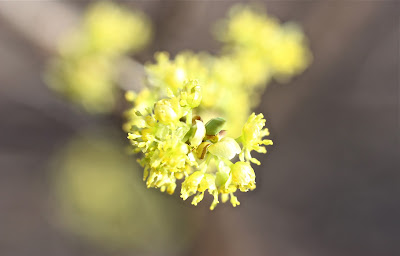On Diplectrona common netspinners, the "meso- and meta-notum [are] divided by transverse fracture lines in [the] posterior third," and the "fore trochantin [is] simple" (i.e. not "forked" like those on Hydropsyche and Cheumatopsyche larvae). (Text is cited from Barbara Peckarsky, et.al., Freshwater Macroinvertebrates, p. 101). I have posted photos of these features in the entry for 3/4/11 -- please go to that entry to see the detail. Other features noted in Peckarsky -- "Pronotum lacking transverse groove...constricted only slightly at posterior border; anterior margin of frontoclypeal apotome symmetrical and entire." (pp. 101-102) These features are actually visible on the larva in the photo at the top of the page. I've pointed them out in the photo below.
Two more photos. In the first, the netspinner has climbed up on the case of a Uenoid caddis; in the second, the larva has turned on its back, showing us the "common netspinner" gills.
___________
A few other treasures from my outing today.
1. A Perlodid stonefly, Malirekus hastatus. I saw a lot of them -- all of them getting mature.
(Same insect; different lighting conditions.)
2. Two of the many Epeorus pleuralis flatheaded mayflies I saw. The first has just recently molted and is almost transparent; the second is one that is fully mature (note the black wing pads.)
3. Flatheaded mayfly, Maccaffertium meririvulanum. They're growing; note the long wing pads. This was a big nymph: I'd say the body was about an inch long.
4. Probably the largest spiny crawler (E. dorothea) that I saw today. Pretty colors and patterns.
5. And a northern case-maker caddisfly larva -- genus Pycnopsyche -- in its 3-sided case made out of sections of leaves. (Nicely layered -- I might add.)
________
(Below: the wildflowers are blooming and the buds on the trees are opening up. A nice time of year to go to the woods.)













No comments:
Post a Comment